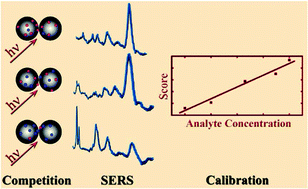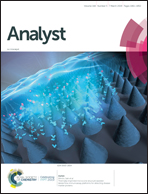Quantitative surface-enhanced Raman spectroscopy chemical analysis using citrate as an in situ calibrant†
Abstract
Direct detection, or inferring the presence of illicit substances, is of great forensic and toxicological value. Surface-enhanced Raman spectroscopy (SERS) has been shown capable of detecting such molecules in a quick and sensitive manner. Herein we describe an analysis strategy for quantitation of low concentrations of three analytes (methamphetamine, cocaine, and papaverine) by SERS analysis using the citrate capping agent that initially saturates the silver nanoparticles’ surface as an in situ standard. The citrate is subsequently displaced by the analyte to an extent dependent on the analyte's concentration in the analyte solution. A general model for the competitive adsorption of citrate and a target analyte was developed and used to determine the relative concentrations of the two species coexisting on the surface of the silver nanoparticles. To apply this model, classical least squares (CLS) was used to extract the relative SERS contribution of each of the two species in a given SERS spectrum, thereby accurately determining the analyte concentration in the sample solution. This approach, in essence, transforms citrate into a local standard against which the concentration of an analyte can be reliably determined.



 Please wait while we load your content...
Please wait while we load your content...
